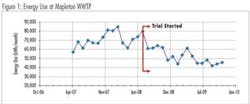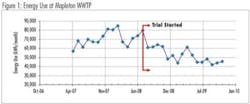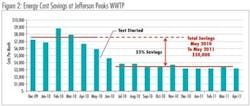New Wastewater Treatment Process Reduces Energy, Carbon Requirements
By Mark LeChevallier
Removal of various pollutants in wastewater is a high cost process, and requires intensive energy input and the addition of chemicals. American Water's research team has developed a new process to achieve the same results in a sustainable manner by saving more than 50 percent of energy and 100 percent of supplemental carbon source when compared to conventional wastewater treatment processes.
For a typical wastewater treatment, approximately half of the total energy consumed is used to maintain a high dissolved oxygen (DO) concentration in the aeration tank to remove the organic matter and ammonia. The increasing cost of energy and carbon sources and stringent wastewater discharge requirements on nitrogen and phosphorus are the main drivers for large water/wastewater utilities such as American Water to constantly seek new opportunities for sustainable design and operation of wastewater treatment plants.
The new NPXpress system, developed by the scientists and engineers at the Innovation and Environmental Stewardship Department of American Water, is able to produce quality treated effluent while using much less oxygen and carbon source. The system's unique operating condition promotes the growth of microorganisms that are able to remove nitrogen and phosphorus in wastewater. These microorganisms require much less oxygen and carbon source to convert ammonia nitrogen to nitrogen gas compared to conventional bacteria found in wastewater treatment systems.
The technology has been installed at two full scale wastewater treatment plants in New Jersey – Mapleton and Jefferson Peaks. Both plants use membrane bioreactors to treat domestic wastewater generated by the nearby communities. The treated effluent is discharged to groundwater.
After implementing the NPXpress technology, the aeration energy consumption at the wastewater treatment plants has been reduced up to 50 percent, while also eliminating the need to add supplemental carbon (micro-C). During and after the implementation, the plant was able to consistently achieve good performance in terms of total nitrogen removal and there were no negative effects observed at the plants. In addition, enhanced biological phosphorus removal was observed as a side benefit for nutrient removal.
Energy Savings
The energy use and energy savings for the two wastewater treatment plants are shown in Figure 1 and Figure 2 respectively. Overall energy consumption at the Mapleton plant (kWh per month) was reduced by approximately 35 percent. The energy intensity in terms of kWh per million gallon wastewater treated at the plant was also reduced by approximately 44 percent.
At Jefferson Peaks, the overall energy consumption for the plant was reduced by approximately 37 percent and the cost saving was approximately 53 percent. The additional saving was attributed to the reduced demand charges from the electricity company.
Implementation of the NPXpress technology required minimal capital improvement to the existing wastewater treatment plants. The simple payback period was calculated by comparing the capital investment and the savings for the two full scale plants. The simple payback period for Mapleton and Jefferson Peaks was 3.1 months and 4.6 months respectively.
Since the conversion of the Jefferson Peaks and Mapleton treatment works, the elimination of supplemental carbon translates to further savings on chemical cost and the related operation and maintenance costs.
Patent Award and On-going Effort
The NPXpress technology was awarded a patent in September 2011. The technology is being installed at six other American Water wastewater treatment plants as part of the company's overall "green" initiatives. The technology has demonstrated promising capabilities to achieve wastewater treatment and nutrient removal in a sustainable way and provided opportunities for wastewater utilities to design, build, and operate an energy neutral wastewater treatment plant.
About the Author: Mark W. LeChevallier, Ph.D., is currently the Director of Innovation & Environmental Stewardship at American Water, the largest publicly traded U.S. water and wastewater utility company, providing drinking water, wastewater and other related services to approximately 15 million people in more than 30 states and parts of Canada. Circle No. 290 on Reader Service Card
More WaterWorld Current Issue Articles
More WaterWorld Archives Issue Articles


